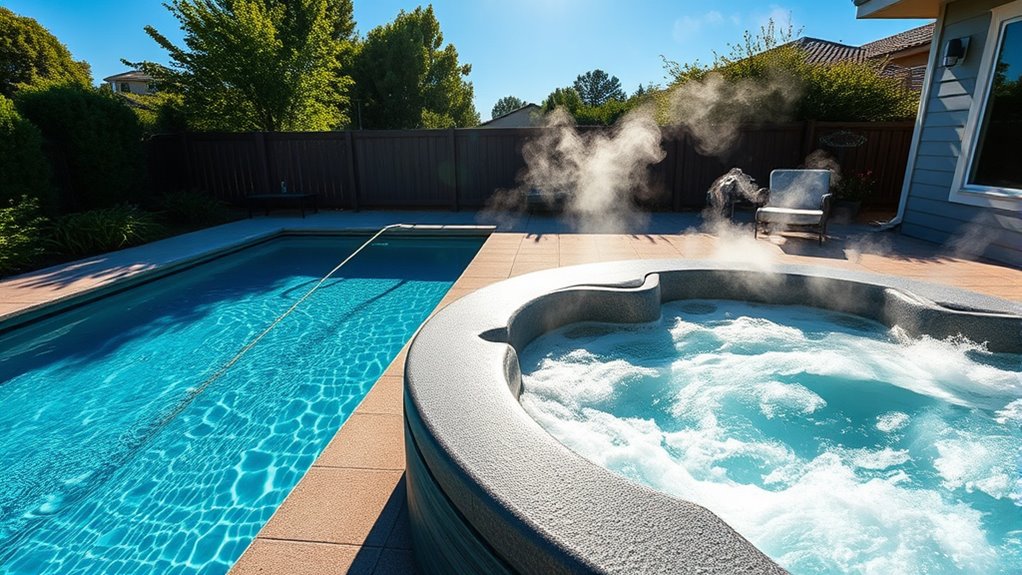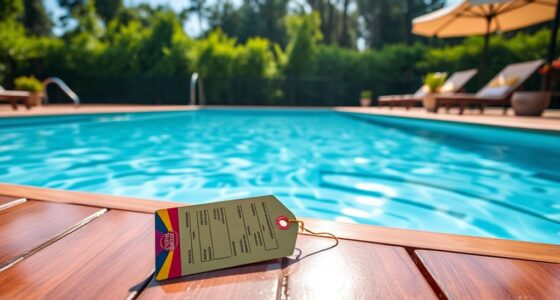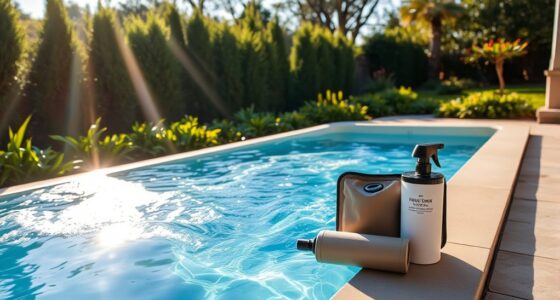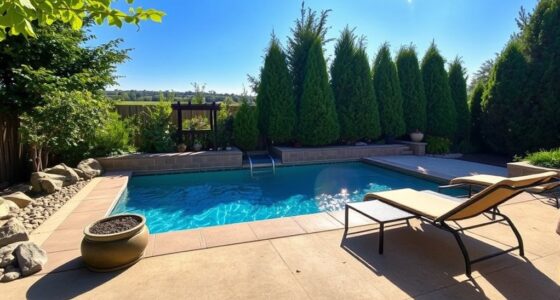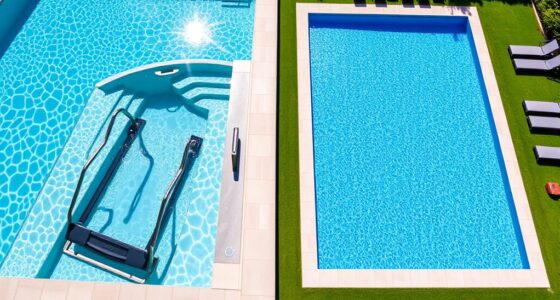If relaxation and stress relief are your priority, a hot tub is a great choice, providing warm water and soothing jets. But if you want to combine relaxation with fitness, a swim spa offers a built-in swimming area for low-impact workouts and active living. Think about what suits your lifestyle best—pure calm or versatile activity—and explore further to find the perfect fit for your needs.
Key Takeaways
- Choose a hot tub for relaxation, stress relief, and intimate socializing without the need for exercise features.
- Opt for a swim spa if you want both relaxation and low-impact swimming or water-based fitness activities.
- Hot tubs are easier to operate and maintain, ideal for those seeking simple, soothing experiences.
- Swim spas support versatile workouts, making them suitable for active users and injury recovery.
- Decide based on your primary goal: relaxation and socializing or fitness and multifunctionality.
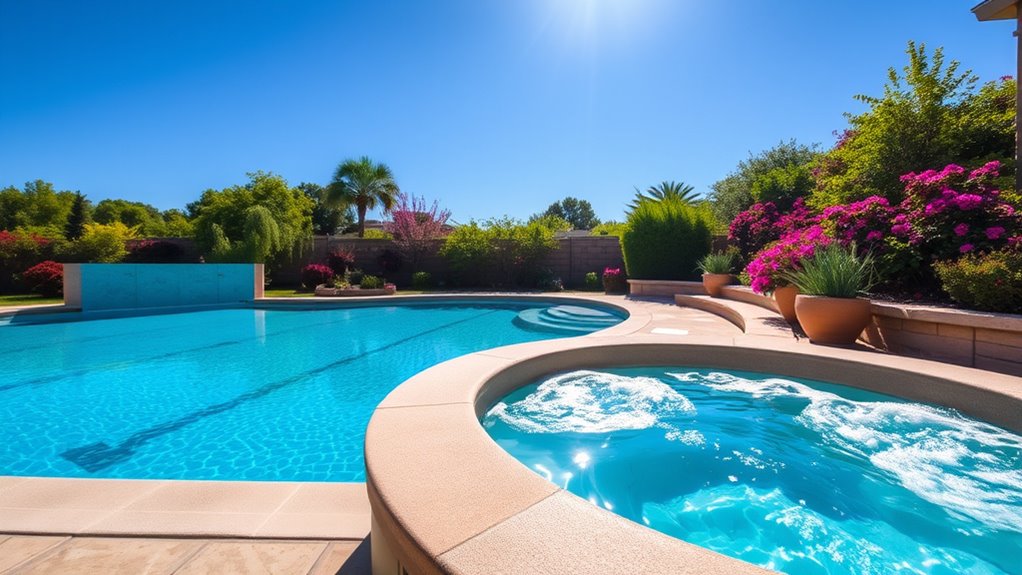
When choosing between a swim spa and a hot tub, understanding their differences can help you make the right decision for your needs. Both options offer relaxation benefits, but they serve different purposes and come with unique features. A hot tub is primarily designed to provide soothing, warm water for unwinding after a long day. Its jets create a massage-like experience that helps relieve tension in your muscles, reduce stress, and enhance overall relaxation. If your main goal is to unwind, de-stress, and enjoy a cozy soak, a hot tub might be the perfect fit. It’s straightforward to operate, relatively compact, and creates an intimate space for relaxation.
On the other hand, a swim spa combines the hot tub experience with a built-in swimming area, making it a versatile addition to your home. The exercise options it offers extend beyond simple relaxation. With adjustable current systems, you can swim against the flow, allowing for low-impact cardiovascular workouts right at home. Whether you’re aiming to train for a competition, recover from injuries, or simply stay active, a swim spa provides a convenient way to incorporate fitness into your routine. Its open design encourages movement and activity, making it suitable for all fitness levels. Plus, you can often use it for water aerobics, resistance training, or just practicing your strokes, all while enjoying the therapeutic benefits of warm water. Additionally, considering the market trends in private wellness options, swim spas are increasingly popular for their multifunctionality.
Choosing between the two ultimately depends on what you value most. If your priority is relaxation and stress relief, a hot tub’s calming jets and warm water will likely meet your needs. It’s easier to set up and maintain, and it’s perfect for socializing or quiet evenings alone. Conversely, if you’re looking for a multi-purpose feature that combines relaxation with a healthy exercise option, a swim spa offers more variety. It allows you to stay active without leaving your backyard, making it a smart investment for those who want both wellness and leisure in one package.
Frequently Asked Questions
Which Option Offers Better Energy Efficiency?
When considering energy consumption, you look for options with better insulation effectiveness. A hot tub generally uses less energy because it’s smaller and designed for immediate use, minimizing heat loss. Swim spas tend to have higher energy consumption due to larger size and continuous use for swimming. If energy efficiency matters most, a well-insulated hot tub might be the better choice, helping you save on electricity bills.
Can I Install a Swim Spa or Hot Tub Indoors?
Thinking of bringing your relaxation indoors, like planting a seed in fertile ground? You can install a swim spa or hot tub indoors, but space considerations are vital. Make certain your space can handle the equipment’s size, weight, and ventilation needs. Proper installation prevents issues like moisture damage or structural strain. Consult professionals to assess your indoor area’s suitability, making sure your new oasis fits comfortably and functions safely.
What Are the Maintenance Requirements for Each?
You need to stay on top of chemical maintenance and cleaning routines for both swim spas and hot tubs. Regularly test the water, adjust pH and sanitizer levels, and clean filters to keep the water clear and safe. Hot tubs may require more frequent chemical adjustments due to their smaller size, while swim spas need routine filter cleaning and water replacement. Consistent upkeep guarantees a pleasant, hygienic experience in either.
How Long Does Installation Typically Take?
The installation timeline varies depending on the unit and setup process. For a hot tub, expect it to take about one to three days, since it’s simpler to install. Swim spas usually require more time, often around three to five days, due to their size and additional setup needs. You’ll want to plan for this installation timeline to make sure everything is ready for your enjoyment without delays.
Are There Health Benefits Unique to Each?
Imagine a sanctuary where your well-being blossoms. A hot tub offers soothing hydrotherapy benefits, easing muscle tension and promoting relaxation. It also supports cardiovascular health through gentle heat and massage. A swim spa, meanwhile, acts as a personal gym, enhancing circulation and endurance with its aquatic resistance. Both provide unique health benefits—hot tubs nurture relaxation, while swim spas boost fitness and cardiovascular strength. Choose based on your wellness goals.
Conclusion
Ultimately, choosing between a swim spa and a hot tub comes down to your priorities: do you want to swim and exercise, relax and unwind, or do both? A swim spa offers the versatility of swimming, fitness, and relaxation, while a hot tub provides soothing warmth and stress relief. Think of it as blending activity with relaxation, fitness with leisure—each option tailored to your lifestyle. Decide what you value most, and let that guide your perfect choice.
